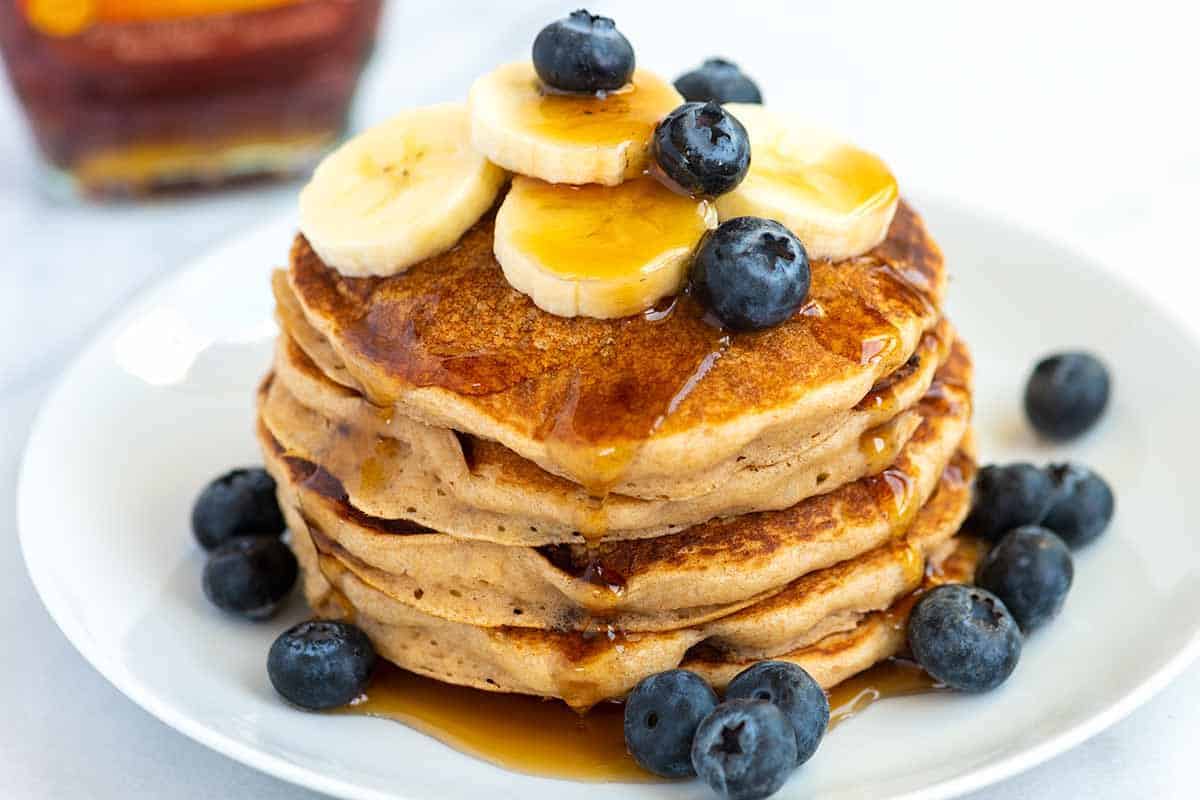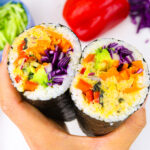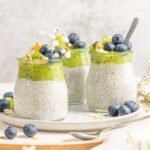Imagine sinking your teeth into a fluffy, subtly sweet raw vegan pancake, bursting with vibrant flavor and wholesome goodness. Forget everything you thought you knew about pancakes – this isn’t your grandma’s recipe. We’re diving into a world of vibrant textures and exciting flavor combinations, where nuts, seeds, and fruits dance together in a symphony of deliciousness. Prepare to unlock the secrets to creating raw vegan pancakes that are not only healthy but utterly irresistible.
This guide takes you on a journey from selecting the perfect ingredients – envisioning creamy nut butters and the vibrant hues of fresh berries – to mastering the art of blending the batter, achieving that perfect consistency. We’ll explore different cooking methods, from the gentle warmth of a dehydrator to the precision of an air fryer, each imparting unique textures and flavors to your culinary creations. Get ready to experiment with diverse recipes, discover innovative topping combinations, and ultimately, craft a breakfast masterpiece that will redefine your morning routine.
Batter Creation Techniques
Crafting the perfect raw vegan pancake batter requires a delicate balance of technique and ingredients. The goal is a smooth, pourable mixture that holds its shape when cooked, resulting in delightful, tender pancakes. Achieving this consistency hinges on proper blending and a precise liquid-to-solid ratio. Different methods and liquid bases can significantly influence the final product’s taste and texture.
The choice between a high-speed blender and a food processor influences the final batter’s texture. High-speed blenders, with their powerful motors and sharp blades, excel at creating exceptionally smooth batters, seamlessly incorporating ingredients and minimizing any lingering chunks. Imagine a creamy, almost silken texture, perfect for delicate pancakes. Food processors, while capable of producing a good batter, may leave slightly more visible texture, resulting in pancakes with a more rustic appearance. The choice ultimately depends on personal preference and the desired level of smoothness.
Liquid-to-Solid Ratio’s Importance
The ratio of liquid to solid ingredients is paramount in determining the pancake batter’s consistency. Too much liquid will result in thin, runny pancakes that might fall apart during cooking. Picture a thin crepe, barely holding its shape. Conversely, insufficient liquid will produce a thick, dense batter, difficult to pour and potentially resulting in tough, dry pancakes – imagine a dense, almost cake-like texture. A good rule of thumb is to start with a slightly less liquid ratio and gradually add more until the batter reaches a pourable, yet slightly thick consistency, similar to thick cream. This allows for easy spreading and ensures the pancakes cook evenly. The exact ratio will vary depending on the specific ingredients used, but careful observation and adjustments during the blending process are key.
Recipe Variations with Different Liquid Bases
Using various liquid bases allows for exciting variations in flavor and texture. A recipe using coconut water, for instance, will impart a subtle sweetness and a slightly creamy texture, with a hint of tropical notes. The pancakes will have a slightly more dense consistency compared to those made with other liquids. Conversely, almond milk yields a milder, nuttier flavor and a lighter, airier texture. The pancakes will be slightly thinner and more delicate. Using a combination of liquids, such as coconut water and a touch of almond milk, allows for a balanced flavor profile and a texture that falls somewhere between the two extremes. Experimenting with different liquid bases opens a world of flavor possibilities, allowing you to tailor your raw vegan pancakes to your preferences. The subtle differences in sweetness, density, and overall taste will become apparent with each variation.
Cooking & Serving Methods

Transforming your vibrant raw vegan pancake batter into delightful, delicate discs requires a gentle touch and the right technique. The beauty of raw vegan cooking lies in preserving the natural enzymes and nutrients, so high heat is a no-no. Let’s explore several methods that achieve perfectly cooked pancakes without compromising their delicate integrity.
Several methods exist for cooking raw vegan pancakes, each offering a unique texture and requiring slightly different attention. The choice depends on your available equipment and desired outcome. Dehydration provides a chewy texture, an air fryer offers a crispier edge, and a low-heat pan creates a softer pancake. Careful attention to timing is crucial for all methods to prevent over-cooking.
Dehydrator Method
The dehydrator is the ideal method for achieving a perfectly textured raw vegan pancake. The slow, even drying process ensures the pancakes retain their moisture while gently firming up. Imagine the subtle, almost translucent edges, hinting at a delicate chewiness within. The color remains vibrant, reflecting the freshness of the ingredients. Arrange the pancakes on the dehydrator trays, ensuring they’re not overcrowded to allow for even airflow. Dehydration times vary depending on the thickness of the pancakes and the dehydrator’s settings, but generally range from 4-8 hours at a low temperature (around 105-115°F or 40-46°C).
Air Fryer Method
For a crispier edge and a slightly firmer texture, the air fryer offers a faster alternative to dehydration. Picture the pancakes, nestled in the air fryer basket, gently puffing up as the warm air circulates. The result is a pancake with a delightful contrast: a slightly crisp exterior and a soft, moist interior. This method requires careful monitoring to prevent burning. Aim for a temperature around 250-275°F (121-135°C) for approximately 5-10 minutes, flipping halfway through. The exact timing depends on your air fryer and the pancake thickness.
Non-Stick Pan Method
A non-stick pan offers a simple, accessible method, though it requires the most attention. The key is to use very low heat. Visualize the pancakes gently cooking on the pan, their edges slowly firming without browning. The texture will be softer than the dehydrator or air fryer methods, more akin to a traditional pancake, but without the high heat cooking. Cook for approximately 2-3 minutes per side, depending on the thickness, adjusting the heat as needed to prevent sticking or burning. A little oil spray can prevent sticking, but use sparingly.
Cooking Time and Texture Comparison
| Method | Time | Texture | Notes |
|---|---|---|---|
| Dehydrator | 4-8 hours | Chewy, slightly firm | Requires even spacing on trays for proper airflow. |
| Air Fryer | 5-10 minutes | Crisp edges, soft interior | Requires careful monitoring to prevent burning. |
| Non-Stick Pan (low heat) | 2-3 minutes per side | Soft, tender | Use very low heat and a non-stick pan to prevent sticking. |
Serving Suggestions
The possibilities for serving raw vegan pancakes are endless. The delicate flavor allows for a wide array of toppings and accompaniments, creating a symphony of textures and tastes. Consider these delightful options to elevate your pancake experience.
Imagine a stack of pancakes adorned with vibrant, freshly sliced berries – juicy strawberries, plump blueberries, and sweet raspberries. A drizzle of maple syrup adds a touch of sweetness, while a sprinkle of chopped nuts – pecans, walnuts, or almonds – provides a delightful crunch. A dusting of chia seeds adds a subtle earthiness and nutritional boost. For a more exotic touch, consider a mango salsa or a passion fruit coulis. Serve alongside a refreshing fruit salad or a side of creamy coconut yogurt for a complete and satisfying meal.
Creating delicious raw vegan pancakes is more than just a recipe; it’s an exploration of texture, flavor, and creativity. From the careful selection of ingredients to the artistry of presentation, each step contributes to a final product that is both nourishing and delightful. Remember the joy of experimenting with different flavor profiles, the satisfaction of mastering the perfect batter consistency, and the pride in sharing your creations with others. So, gather your ingredients, embrace the process, and prepare to embark on a culinary adventure that will leave you feeling energized, satisfied, and ready to tackle the day ahead. The possibilities are endless – now go forth and create your own pancake paradise!
FAQ Guide
What if my batter is too thick?
Add a tablespoon or two of liquid (water, almond milk, or coconut water) at a time, blending until you reach your desired consistency.
Can I store leftover pancakes?
Yes! Store them in an airtight container in the refrigerator for up to 3-4 days. They may become slightly firmer upon refrigeration.
Are raw vegan pancakes really nutritious?
Absolutely! They’re packed with vitamins, minerals, and healthy fats from the nuts, seeds, and fruits used in the recipe. They are a great source of fiber and antioxidants.
What if my pancakes stick to the cooking surface?
Ensure your cooking surface is lightly oiled or use parchment paper to prevent sticking. Lowering the heat can also help.
Can I use other sweeteners besides the ones listed?
Yes, you can experiment with other liquid sweeteners like date syrup or even a touch of maple syrup, but keep in mind that this will affect the overall sweetness and texture.


